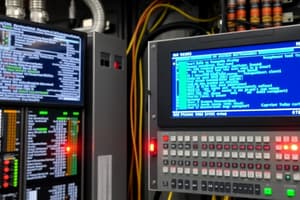Podcast
Questions and Answers
What is the primary goal of PLC programming training according to the Terminal Learning Objective (TLO)?
What is the primary goal of PLC programming training according to the Terminal Learning Objective (TLO)?
- To familiarize learners with different brands of PLCs used in industrial settings.
- To enable learners to create, repair, and improve PLC programs for use in automation, ensuring efficiency and integration. (correct)
- To educate learners about the theoretical aspects of PLC technology without hands-on experience.
- To teach learners how to install and maintain PLC hardware components exclusively.
Which of the following actions demonstrates the application of 'Logic Development & Programming' ELO?
Which of the following actions demonstrates the application of 'Logic Development & Programming' ELO?
- Calibrating pressure sensors connected to a PLC-controlled process.
- Configuring network settings on an industrial Ethernet switch.
- Designing a Ladder Logic program for a conveyor system with safety interlocks. (correct)
- Replacing faulty PLC hardware components in an automated system.
A PLC-controlled system is experiencing intermittent failures. Which ELO is most applicable to systematically address this issue?
A PLC-controlled system is experiencing intermittent failures. Which ELO is most applicable to systematically address this issue?
- Debugging & Troubleshooting. (correct)
- Logic Development & Programming.
- System Integration & Optimization.
- Predictive Maintenance Strategies.
Which task exemplifies the 'System Integration & Optimization' ELO in PLC programming?
Which task exemplifies the 'System Integration & Optimization' ELO in PLC programming?
Which of the following activities could improve performance and maintainability of PLC code, aligning with the 'Logic Development & Programming' ELO?
Which of the following activities could improve performance and maintainability of PLC code, aligning with the 'Logic Development & Programming' ELO?
What does implementing predictive maintenance strategies entail, as per the 'Debugging & Troubleshooting' ELO?
What does implementing predictive maintenance strategies entail, as per the 'Debugging & Troubleshooting' ELO?
When integrating a PLC with other industrial components, what key aspect does the configuration and troubleshooting of industrial communication protocols address?
When integrating a PLC with other industrial components, what key aspect does the configuration and troubleshooting of industrial communication protocols address?
Flashcards
Terminal Learning Objective (TLO)
Terminal Learning Objective (TLO)
Overall goal: Program PLCs for automated systems that work reliably and efficiently with other parts.
PLC Programming Languages
PLC Programming Languages
PLC programming languages like Ladder Logic, Structured Text, and Function Block.
Structured and Modular PLC Programs
Structured and Modular PLC Programs
Creating PLC code that is easy to understand, update, and keep running smoothly.
Optimize PLC Code
Optimize PLC Code
Signup and view all the flashcards
Debugging & Troubleshooting
Debugging & Troubleshooting
Signup and view all the flashcards
Debugging Tools
Debugging Tools
Signup and view all the flashcards
System Integration
System Integration
Signup and view all the flashcards
Study Notes
- Training objective focuses on enabling learners to develop, debug, and optimize PLC programs for industrial automation systems.
- Ensures seamless integration with other control components.
- Focuses on maintaining efficiency and reliability.
Logic Development & Programming:
- Understand and apply PLC programming languages, including Ladder Logic, Structured Text, and Function Block.
- Develop structured and modular PLC programs following industry best practices.
- Optimize PLC code for performance and maintainability.
Debugging & Troubleshooting:
- Identify and diagnose PLC programming errors and hardware faults.
- Utilize debugging tools and troubleshooting techniques to resolve automation issues.
- Implement predictive maintenance strategies to prevent system failures.
System Integration & Optimization:
- Integrate PLCs with HMIs, SCADA, industrial sensors, and field devices.
- Configure and troubleshoot industrial communication protocols (Modbus, Ethernet/IP, Profibus, etc.).
- Optimize control system performance for reliability and efficiency.
Studying That Suits You
Use AI to generate personalized quizzes and flashcards to suit your learning preferences.




